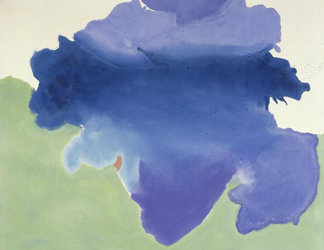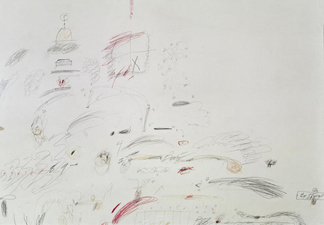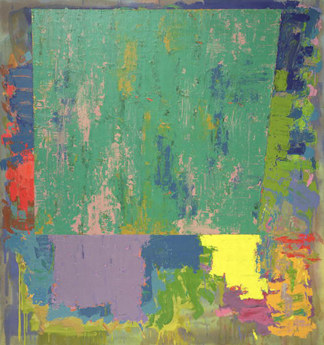Published 16/01/2012
2011 saw the passing of many 20th century art giants.
|
Helen Frankenthaler (1928-2011) The second-generation Abstract Expressionist heroine was a printmaker, sculptor and painter in the subset of 'Color Field' painting. Perhaps because of her wealthy background Frankenthaler was a prolific artist with a focus on proving herself through her work. She arguably had the longest, most productive and most successful career of any female artist with her work selling far above her female peers. The watercolor effect of her paintings was achieved by a technique known as 'soak stain.' The heavily diluted oil paint was applied directly to a raw canvas so that the material would absorb the colors. |

|
The pre-eminent German-born British painter known for his fleshy nudes and psychologically-tinged portraits passed away in July. Easily identifiable by his highly textured style, his portraits can be mesmerizing and equally uncomfortable for the viewer. In 2008, his portrait of an obese, naked, Sue Tilley sold for $33.6 million at Christie's in New York. The sale of the painting, Benefits Supervisor Sleeping, set the world record for the highest price paid for a work by a living artist.
"I'm not frightened in the slightest of death; I've had a lovely time." - Lucian Freud to friend, Martin Gayford.
(Daily Telegraph)

|

|
Leonora Carrington (1917-2011) The British-born Mexican author and surrealist painter, who defied her family's wish for her to become a social-climbing debutante and instead went to art school, died in May. In London and Paris, she was drawn into friendship with the Surrealists, including a romance with her future husband Max Ernst. During the occupation of France, Ernst was arrested by the Nazis and Carrington fled to Spain where she was subsequently institutionalized by her family. She was finally able to escape to Mexico where she lived the remainder of her life. Carrington's adopted homeland's mythology and history are reflected in her work. |
|
British-born and Royal Academy educated printmaker and collage artist, Richard Hamilton died in September. Hamilton belonged to the Independent Group, a mix of artists and writers at the Institute of Contemporary Arts whose discussions contributed to the development of Pop Art in Britian. His most famous work, "What is it that Makes Today's Homes So Different, So Appealing?" (right) is considered by critics to be one of the early works of the Pop movement. The week before his death at 89, he was working on a major restrospective of his work which will open at the Museum of Contemporary Art, LA in 2013 and travel to Philadelphia, London and Madrid. |

|
|

|
The American artist known for his calligraphic style of scratching, doodling and writing died in July. Born in Virginia, Twombly worked in New York City at the height of Abstract Expressionism amidst contemporaries like Jasper Johns and Robert Rauschenberg. His exposure to the emerging New York School greatly influenced his movement away from figures. On the other side of the spectrum, Twombly was greatly inspired by Classical antiquity and moved to Rome in 1957 where the region captured his imagination and became a repetitive theme in his work. In 2010, Twombly became the first artist since Georges Braque in the 1950s to be invited to paint a ceiling in the Louvre. |
|
The youngest artist to ever receive a retrospective at the Whitechapel Gallery in 1967, the British painter is best known for helping to initiate the abstract scene in 1960s London. His paintings are identifiable by the use of vivid, saturated color. He is sometimes referred to as Europe's answer to Mark Rothko. The British realist and, later, abstract artist was known for his role in the Beaux Arts quartet of the 1950s. Smith, along with John Bratby, Derrick Greaves and Edward Middleditch would come to be known as the "Kitchen Sink" painters. Although it is said that he hated that classification, his paintings reflected the movement's gritty representational style. The last fifty years of his life were devoted to abstract subjects, in a style reflective of Kandinsky. |

|
|

|
American artist Dennis Oppenheim was a giant of the Conceptual Art and Land Art movements. He worked in many different genres such as photography, performance art and large scale sculpture. Oppenheim used his art as a statement and was at the center of many controversies. One such controversy was his 1997 "Device to Root Out Evil" which featured an upside down church sticking into the ground. In the 1970s, Oppenheim was on the forefront of using film and video in relation to performance art. Read obituary from The Huffington Post. Last but certainly not least, two American artists known for their work in post-war California died in 2011. John McCracken, known for his geometric painted sculptures was a major figure in the postwar arts landscape. Read more in the LA Times obituary. The Abstract-Expressionist sculptor, Stephen De Staebler was best known for his use of the deconstructed human figures in stone and bronze. Read more about the artist. De Staebler is now the focus of an exhibition at San Francisco's DeYoung Museum, running until April 2012.
|


